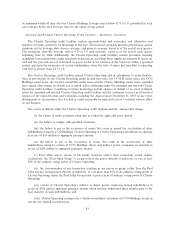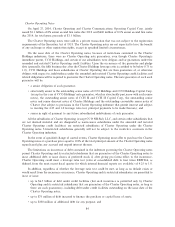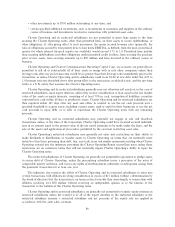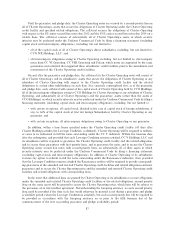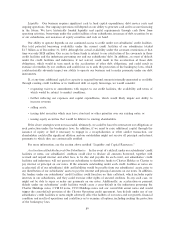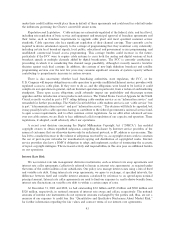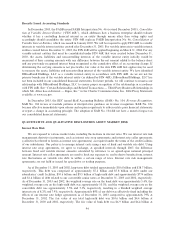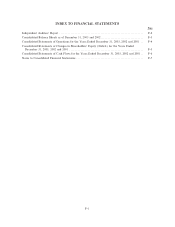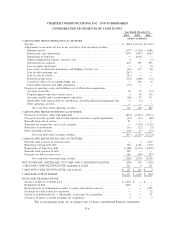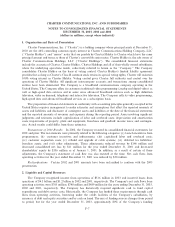Charter 2003 Annual Report Download - page 95
Download and view the complete annual report
Please find page 95 of the 2003 Charter annual report below. You can navigate through the pages in the report by either clicking on the pages listed below, or by using the keyword search tool below to find specific information within the annual report.under their credit facilities would place them in default of these agreements and could result in a default under
the indentures governing the Charter convertible senior notes.
Regulation and Legislation. Cable systems are extensively regulated at the federal, state, and local level,
including rate regulation of basic service and equipment and municipal approval of franchise agreements and
their terms, such as franchise requirements to upgrade cable plant and meet speciÑed customer service
standards. Cable operators also face signiÑcant regulation of their channel carriage. They currently can be
required to devote substantial capacity to the carriage of programming that they would not carry voluntarily,
including certain local broadcast signals, local public, educational and government access programming, and
unaÇliated commercial leased access programming. This carriage burden could increase in the future,
particularly if the FCC were to require cable systems to carry both the analog and digital versions of local
broadcast signals or multiple channels added by digital broadcasters. The FCC is currently conducting a
proceeding in which it is considering this channel usage possibility, although it recently issued a tentative
decision against such dual carriage. In addition, the carriage of new high deÑnition broadcast and satellite
programming services over the next few years may consume signiÑcant amounts of system capacity without
contributing to proportionate increases in system revenue.
There is also uncertainty whether local franchising authorities, state regulators, the FCC, or the
U.S. Congress will impose obligations on cable operators to provide unaÇliated Internet service providers with
regulated access to cable plant. If they were to do so, and the obligations were found to be lawful, it could
complicate our operations in general, and our Internet operations in particular, from a technical and marketing
standpoint. These open access obligations could adversely impact our proÑtability and discourage system
upgrades and the introduction of new products and services. The United States Court of Appeals for the Ninth
Circuit recently vacated in part a FCC ruling deÑning cable modem service as an ""information service'' and
remanded for further proceedings. The Ninth Circuit held that cable modem service is not ""cable service'' but
is part ""telecommunications service'' and part ""information service.'' The decision will likely be appealed, but
it may possibly lead to cable operators having to contribute to the federal government's universal service fund,
to open access requirements, and to other common carrier regulations. As we oÅer other advanced services
over our cable system, we are likely to face additional calls for regulation of our capacity and operation. These
regulations, if adopted, could adversely aÅect our operations.
A recent court decision concerning the Digital Millennium Copyright Act (""DMCA'') has enabled
copyright owners to obtain expedited subpoenas compelling disclosure by Internet service providers of the
names of customers that are otherwise known only by an Internet protocol, or IP, address or screen name. This
has led to a marked increase in the volume of subpoenas received by us, as copyright owners seek to constrain
the use of peer-to-peer networks for unauthorized copying and distribution of copyrighted works. Internet
service providers also have a DMCA obligation to adopt and implement a policy of terminating the accounts
of repeat copyright infringers. The increased activity and responsibilities in this area pose an additional burden
on our operations.
Interest Rate Risk
We use interest rate risk management derivative instruments, such as interest rate swap agreements and
interest rate collar agreements (collectively referred to herein as interest rate agreements) as required under
the terms of the credit facilities of our subsidiaries. Our policy is to manage interest costs using a mix of Ñxed
and variable rate debt. Using interest rate swap agreements, we agree to exchange, at speciÑed intervals, the
diÅerence between Ñxed and variable interest amounts calculated by reference to an agreed-upon notional
principal amount. Interest rate collar agreements are used to limit our exposure to, and to derive beneÑts from,
interest rate Öuctuations on variable rate debt to within a certain range of rates.
At December 31, 2003 and 2002, we had outstanding $3.0 billion and $3.4 billion and $520 million and
$520 million, respectively, in notional amounts of interest rate swaps and collars, respectively. The notional
amounts of interest rate instruments do not represent amounts exchanged by the parties and, thus, are not a
measure of our exposure to credit loss. See ""Quantitative and Qualitative Disclosures About Market Risk,''
for further information regarding the fair values and contract terms of our interest rate agreements.
93


